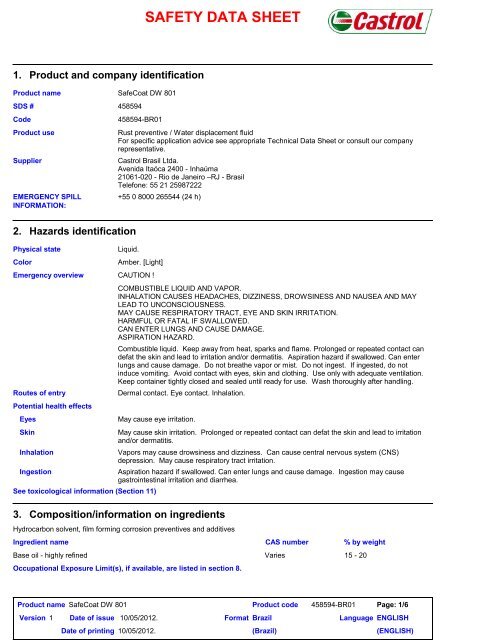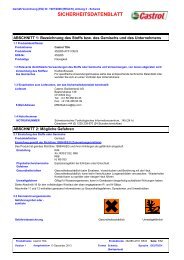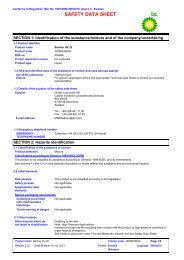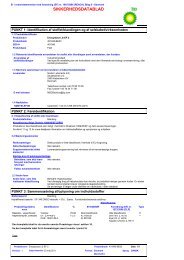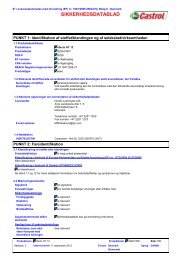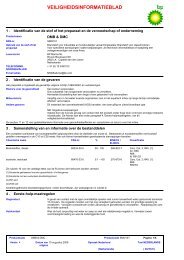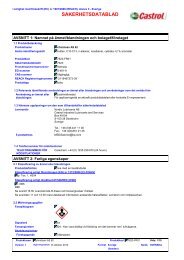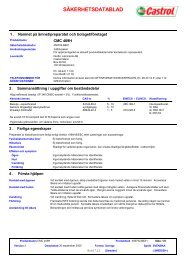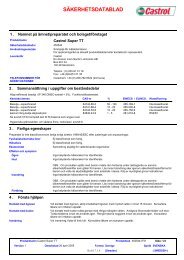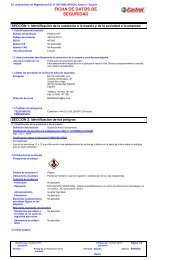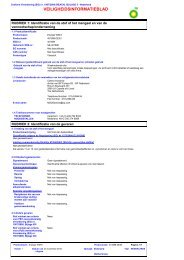(US)154404SafeCoat DW 801.pdf - BP - PDS & MSDS Search
(US)154404SafeCoat DW 801.pdf - BP - PDS & MSDS Search
(US)154404SafeCoat DW 801.pdf - BP - PDS & MSDS Search
You also want an ePaper? Increase the reach of your titles
YUMPU automatically turns print PDFs into web optimized ePapers that Google loves.
1. Product and company identification<br />
Product name SafeCoat <strong>DW</strong> 801<br />
SDS # 458594<br />
Code 458594-BR01<br />
SAFETY DATA SHEET<br />
Product use Rust preventive / Water displacement fluid<br />
For specific application advice see appropriate Technical Data Sheet or consult our company<br />
representative.<br />
Supplier Castrol Brasil Ltda.<br />
Avenida Itaóca 2400 - Inhaúma<br />
21061-020 - Rio de Janeiro –RJ - Brasil<br />
Telefone: 55 21 25987222<br />
EMERGENCY SPILL<br />
INFORMATION:<br />
2. Hazards identification<br />
Physical state<br />
+55 0 8000 265544 (24 h)<br />
Color Amber. [Light]<br />
Emergency overview CAUTION !<br />
Routes of entry<br />
Potential health effects<br />
Liquid.<br />
Dermal contact. Eye contact. Inhalation.<br />
Eyes May cause eye irritation.<br />
Skin May cause skin irritation. Prolonged or repeated contact can defat the skin and lead to irritation<br />
and/or dermatitis.<br />
Inhalation Vapors may cause drowsiness and dizziness. Can cause central nervous system (CNS)<br />
depression. May cause respiratory tract irritation.<br />
Ingestion Aspiration hazard if swallowed. Can enter lungs and cause damage. Ingestion may cause<br />
gastrointestinal irritation and diarrhea.<br />
See toxicological information (Section 11)<br />
COMB<strong>US</strong>TIBLE LIQUID AND VAPOR.<br />
INHALATION CA<strong>US</strong>ES HEADACHES, DIZZINESS, DROWSINESS AND NA<strong>US</strong>EA AND MAY<br />
LEAD TO UNCONSCIO<strong>US</strong>NESS.<br />
MAY CA<strong>US</strong>E RESPIRATORY TRACT, EYE AND SKIN IRRITATION.<br />
HARMFUL OR FATAL IF SWALLOWED.<br />
CAN ENTER LUNGS AND CA<strong>US</strong>E DAMAGE.<br />
ASPIRATION HAZARD.<br />
Combustible liquid. Keep away from heat, sparks and flame. Prolonged or repeated contact can<br />
defat the skin and lead to irritation and/or dermatitis. Aspiration hazard if swallowed. Can enter<br />
lungs and cause damage. Do not breathe vapor or mist. Do not ingest. If ingested, do not<br />
induce vomiting. Avoid contact with eyes, skin and clothing. Use only with adequate ventilation.<br />
Keep container tightly closed and sealed until ready for use. Wash thoroughly after handling.<br />
3. Composition/information on ingredients<br />
Hydrocarbon solvent, film forming corrosion preventives and additives<br />
Ingredient name CAS number % by weight<br />
Base oil - highly refined Varies 15 - 20<br />
Occupational Exposure Limit(s), if available, are listed in section 8.<br />
Product name SafeCoat <strong>DW</strong> 801<br />
Product code<br />
Page: 1/6<br />
Version 1 Date of issue 10/05/2012.<br />
Format Brazil<br />
Language ENGLISH<br />
Date of printing 10/05/2012. (Brazil)<br />
458594-BR01<br />
(ENGLISH)
4. First aid measures<br />
Eye contact In case of contact, immediately flush eyes with plenty of water for at least 15 minutes. Get<br />
medical attention if symptoms occur.<br />
Skin contact Immediately wash exposed skin with soap and water. Remove contaminated clothing and shoes.<br />
Wash clothing before reuse. Clean shoes thoroughly before reuse. Get medical attention if<br />
symptoms occur.<br />
Inhalation If inhaled, remove to fresh air. If it is suspected that fumes are still present, the rescuer should<br />
wear an appropriate mask or self-contained breathing apparatus. If not breathing, give artificial<br />
respiration. If breathing is difficult, give oxygen. Get medical attention immediately.<br />
Ingestion Aspiration hazard if swallowed. Can enter lungs and cause damage. Do not induce vomiting.<br />
Never give anything by mouth to an unconscious person. Get medical attention immediately.<br />
Notes to physician Treatment should in general be symptomatic and directed to relieving any effects.<br />
Aspiration of this material into the lungs can cause chemical pneumonia and can be fatal.<br />
Aspiration into the lungs can occur while vomiting after ingestion of this material.<br />
5. Fire-fighting measures<br />
Flammability of the<br />
product<br />
Flash point Open cup: 90°C (194°F) [Cleveland.]<br />
Fire/explosion hazards<br />
Extinguishing media<br />
Fire-fighting procedures<br />
Hazardous combustion<br />
products<br />
In a fire or if heated, a pressure increase will occur and the container may burst, with the risk of a<br />
subsequent explosion.<br />
Suitable Use dry chemical, CO₂, water spray (fog) or foam.<br />
Not suitable<br />
Combustible liquid.<br />
Do not use water jet.<br />
Promptly isolate the scene by removing all persons from the vicinity of the incident if there is a fire.<br />
No action shall be taken involving any personal risk or without suitable training. Move containers<br />
from fire area if this can be done without risk. Use water spray to keep fire-exposed containers<br />
cool.<br />
Combustion products may include the following:<br />
carbon oxides (CO, CO2) (carbon monoxide, carbon dioxide)<br />
Protective clothing (fire) Fire-fighters should wear appropriate protective equipment and self-contained breathing<br />
apparatus (SCBA) with a full face-piece operated in positive pressure mode.<br />
6. Accidental release measures<br />
Personal precautions<br />
Environmental<br />
precautions<br />
Methods for cleaning up<br />
Large spill<br />
Small spill<br />
No action shall be taken involving any personal risk or without suitable training. Keep<br />
unnecessary and unprotected personnel from entering. Do not touch or walk through spilled<br />
material. Shut off all ignition sources. No flares, smoking or flames in hazard area. Do not<br />
breathe vapor or mist. Provide adequate ventilation. Wear appropriate respirator when<br />
ventilation is inadequate. Put on appropriate personal protective equipment (see Section 8).<br />
Avoid dispersal of spilled material and runoff and contact with soil, waterways, drains and sewers.<br />
Inform the relevant authorities if the product has caused environmental pollution (sewers,<br />
waterways, soil or air).<br />
Stop leak if without risk. Move containers from spill area. Approach release from upwind.<br />
Prevent entry into sewers, water courses, basements or confined areas. Wash spillages into an<br />
effluent treatment plant or proceed as follows. Contain and collect spillage with non-combustible,<br />
absorbent material e.g. sand, earth, vermiculite or diatomaceous earth and place in container for<br />
disposal according to local regulations (see Section 13). Use spark-proof tools and explosionproof<br />
equipment. Dispose of via a licensed waste disposal contractor. Contaminated absorbent<br />
material may pose the same hazard as the spilled product. Note: see Section 1 for emergency<br />
contact information and Section 13 for waste disposal.<br />
Stop leak if without risk. Move containers from spill area. Dilute with water and mop up if watersoluble.<br />
Alternatively, or if water-insoluble, absorb with an inert dry material and place in an<br />
appropriate waste disposal container. Use spark-proof tools and explosion-proof equipment.<br />
Dispose of via a licensed waste disposal contractor.<br />
Product name SafeCoat <strong>DW</strong> 801<br />
Product code<br />
Page: 2/6<br />
Version 1 Date of issue 10/05/2012.<br />
Format Brazil<br />
Language ENGLISH<br />
Date of printing 10/05/2012. (Brazil)<br />
458594-BR01<br />
(ENGLISH)
7. Handling and storage<br />
Handling Put on appropriate personal protective equipment (see Section 8). Workers should wash hands<br />
and face before eating, drinking and smoking. Do not breathe vapor or mist. Do not ingest.<br />
Avoid contact with eyes, skin and clothing. Use only with adequate ventilation. Wear appropriate<br />
respirator when ventilation is inadequate. Do not enter storage areas and confined spaces unless<br />
adequately ventilated. Store and use away from heat, sparks, open flame or any other ignition<br />
source. Use explosion-proof electrical (ventilating, lighting and material handling) equipment.<br />
Use non-sparking tools. Take precautionary measures against electrostatic discharges. To avoid<br />
fire or explosion, dissipate static electricity during transfer by grounding and bonding containers<br />
and equipment before transferring material.<br />
Storage Store in accordance with local regulations. Store in a segregated and approved area. Store away<br />
from direct sunlight in a dry, cool and well-ventilated area, away from incompatible materials (see<br />
Section 10). Eliminate all ignition sources. Separate from oxidizing materials. Keep container<br />
tightly closed and sealed until ready for use. Containers that have been opened must be carefully<br />
resealed and kept upright to prevent leakage. Do not store in unlabeled containers. Use<br />
appropriate containment to avoid environmental contamination.<br />
8. Exposure controls/personal protection<br />
Occupational exposure limits<br />
Ingredient name<br />
Occupational exposure limits<br />
Base oil - highly refined ACGIH TLV (United States).<br />
TWA: 5 mg/m³ 8 hours. Form: Mineral oil, mist<br />
For information and guidance, the ACGIH values are included. For further information on these please consult your supplier.<br />
While specific OELs for certain components may be shown in this section, other components may be present in any mist, vapor or<br />
dust produced. Therefore, the specific OELs may not be applicable to the product as a whole and are provided for guidance only.<br />
Control Measures Use only with adequate ventilation. Use process enclosures, local exhaust ventilation or other<br />
engineering controls to keep worker exposure to airborne contaminants below any recommended<br />
or statutory limits. The engineering controls also need to keep gas, vapor or dust concentrations<br />
below any lower explosive limits. Use explosion-proof ventilation equipment.<br />
Hygiene measures Wash hands, forearms and face thoroughly after handling chemical products, before eating,<br />
smoking and using the lavatory and at the end of the working period. Appropriate techniques<br />
should be used to remove potentially contaminated clothing. Wash contaminated clothing before<br />
reusing.<br />
Personal protection<br />
9.<br />
Eyes Avoid contact with eyes. Safety glasses with side shields or chemical goggles.<br />
Skin and body Avoid contact with skin and clothing. Wear suitable protective clothing.<br />
Respiratory Use adequate ventilation. Do not breathe vapor or mist.<br />
Hands The correct choice of protective gloves depends upon the chemicals being handled, the conditions<br />
of work and use, and the condition of the gloves (even the best chemically resistant glove will<br />
break down after repeated chemical exposures). Most gloves provide only a short time of<br />
protection before they must be discarded and replaced. Because specific work environments and<br />
material handling practices vary, safety procedures should be developed for each intended<br />
application. Gloves should therefore be chosen in consultation with the supplier/manufacturer and<br />
with a full assessment of the working conditions.<br />
Physical and chemical properties<br />
Physical state Liquid.<br />
Color Amber. [Light]<br />
Odor Mild.<br />
Flash point Open cup: 90°C (194°F) [Cleveland.]<br />
Density<br />
845 kg/m³ (0.845 g/cm³) at 20°C<br />
Viscosity Kinematic:
Solubility insoluble in water.<br />
10. Stability and reactivity<br />
Stability and reactivity<br />
Possibility of hazardous<br />
reactions<br />
Conditions to avoid<br />
Incompatibility with<br />
various substances<br />
Hazardous decomposition<br />
products<br />
Hazardous polymerization<br />
The product is stable.<br />
11. Toxicological information<br />
Other information<br />
Potential chronic health effects<br />
Under normal conditions of storage and use, hazardous reactions will not occur.<br />
Avoid all possible sources of ignition (spark or flame).<br />
Reactive or incompatible with the following materials: oxidizing materials.<br />
Under normal conditions of storage and use, hazardous decomposition products should not be<br />
produced.<br />
Under normal conditions of storage and use, hazardous polymerization will not occur.<br />
May cause nausea, dizziness, headaches and drowsiness if high concentrations of vapor are<br />
inhaled.<br />
Carcinogenicity No known significant effects or critical hazards.<br />
12. Ecological information<br />
Ecotoxicity<br />
No testing has been performed by the manufacturer.<br />
Persistence/degradability<br />
Mobility Volatile. Liquid. insoluble in water.<br />
Bioaccumulative potential<br />
13. Disposal considerations<br />
No testing has been performed by the manufacturer.<br />
No testing has been performed by the manufacturer.<br />
Waste information The generation of waste should be avoided or minimized wherever possible. Disposal of this<br />
product, solutions and any by-products should at all times comply with the requirements of<br />
environmental protection and waste disposal legislation and any regional local authority<br />
requirements. Dispose of surplus and non-recyclable products via a licensed waste disposal<br />
contractor. Waste should not be disposed of untreated to the sewer unless fully compliant with<br />
the requirements of all authorities with jurisdiction. Waste packaging should be recycled.<br />
Incineration or landfill should only be considered when recycling is not feasible. This material and<br />
its container must be disposed of in a safe way. Care should be taken when handling emptied<br />
containers that have not been cleaned or rinsed out. Empty containers or liners may retain some<br />
product residues. Vapor from product residues may create a highly flammable or explosive<br />
atmosphere inside the container. Do not cut, weld or grind used containers unless they have<br />
been cleaned thoroughly internally. Avoid dispersal of spilled material and runoff and contact with<br />
soil, waterways, drains and sewers.<br />
NOTE: The generator of waste has the responsibility for proper waste identification (based on characteristic(s) or listing),<br />
transportation and disposal<br />
14. Transport information<br />
International transport regulations<br />
Product name SafeCoat <strong>DW</strong> 801<br />
Product code<br />
Page: 4/6<br />
Version 1 Date of issue 10/05/2012.<br />
Format Brazil<br />
Language ENGLISH<br />
Date of printing 10/05/2012. (Brazil)<br />
458594-BR01<br />
(ENGLISH)
Regulatory<br />
information<br />
DOT<br />
Classification<br />
TDG<br />
Classification<br />
IMDG<br />
Classification<br />
IATA/ICAO<br />
Classification<br />
Mexico<br />
Classification<br />
UN<br />
number<br />
NA1993<br />
Not<br />
regulated.<br />
Not<br />
regulated.<br />
Not<br />
regulated.<br />
Not<br />
regulated.<br />
15. Regulatory information<br />
Other regulations<br />
Canada inventory<br />
United States inventory<br />
(TSCA 8b)<br />
Australia inventory (AICS)<br />
China inventory (IECSC)<br />
Japan inventory (ENCS)<br />
Korea inventory (KECI)<br />
Philippines inventory<br />
(PICCS)<br />
Proper shipping name Class Packing group Additional information<br />
Combustible liquid, n.o.s.<br />
(Petroleum naphtha)<br />
-<br />
-<br />
Combustible<br />
liquid.<br />
-<br />
-<br />
- -<br />
III -<br />
- - - -<br />
- - - -<br />
All components are listed or exempted.<br />
All components are listed or exempted.<br />
REACH Status For the REACH status of this product please consult your company contact, as identified in<br />
Section 1.<br />
16. Other information<br />
Label requirements CAUTION !<br />
History<br />
Date of issue<br />
Date of previous issue<br />
Prepared by Product Stewardship<br />
Notice to reader<br />
At least one component is not listed.<br />
All components are listed or exempted.<br />
All components are listed or exempted.<br />
All components are listed or exempted.<br />
All components are listed or exempted.<br />
COMB<strong>US</strong>TIBLE LIQUID AND VAPOR.<br />
INHALATION CA<strong>US</strong>ES HEADACHES, DIZZINESS, DROWSINESS AND NA<strong>US</strong>EA AND MAY<br />
LEAD TO UNCONSCIO<strong>US</strong>NESS.<br />
MAY CA<strong>US</strong>E RESPIRATORY TRACT, EYE AND SKIN IRRITATION.<br />
HARMFUL OR FATAL IF SWALLOWED.<br />
CAN ENTER LUNGS AND CA<strong>US</strong>E DAMAGE.<br />
ASPIRATION HAZARD.<br />
10/05/2012.<br />
No previous validation.<br />
Indicates information that has changed from previously issued version.<br />
All reasonably practicable steps have been taken to ensure this data sheet and the health, safety and environmental information<br />
contained in it is accurate as of the date specified below.<br />
The data and advice given apply when the product is sold and applied for the stated application or applications. You should not use<br />
the product other than for the stated application or applications without seeking advice from us.<br />
It is the user’s obligation to evaluate and use this product safely and to comply with all applicable laws and regulations. The <strong>BP</strong><br />
Group shall not be responsible for any damage or injury resulting from use, other than the stated product use of the material, from<br />
any failure to adhere to recommendations. Purchasers of the product for supply to a third party for use at work, have a duty to take<br />
all necessary steps to ensure that any person handling or using the product is provided with the information in this sheet.<br />
Product name SafeCoat <strong>DW</strong> 801<br />
Product code<br />
Version 1 Date of issue 10/05/2012.<br />
Format Brazil<br />
Language ENGLISH<br />
Date of printing 10/05/2012. (Brazil)<br />
-<br />
-<br />
458594-BR01<br />
Page: 5/6<br />
(ENGLISH)
Employers have a duty to tell employees and others who may be affected of any hazards described in this sheet and of any<br />
precautions that should be taken.<br />
Product name SafeCoat <strong>DW</strong> 801<br />
Product code<br />
Page: 6/6<br />
Version 1 Date of issue 10/05/2012.<br />
Format Brazil<br />
Language ENGLISH<br />
Date of printing 10/05/2012. (Brazil)<br />
458594-BR01<br />
(ENGLISH)


